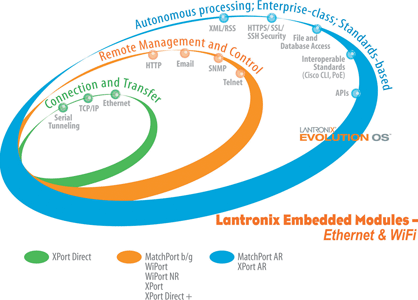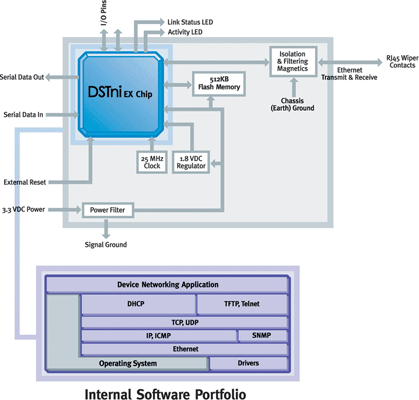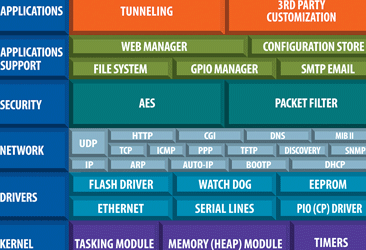
Networking has become widespread in numerous facets of today’s business world and consumer marketplace. With innumerable types of devices and equipment waiting to send and receive information over a network or the Internet, the question arises as to how to access and control them.
Size, cost, time-to-market, Internet protocols and supporting resources have been factors that influenced the adoption of embedded device networking. Having faced these challenges, embedded products have been designed which achieve comprehensive connectivity for devices and equipment to communicate. Employing such technology introduces the task of managing the embedded device connections.
Networking as a necessity
The motivation to network-enable a product has spread to the extent that almost any embedded device now includes networking capabilities as a fundamental design feature, anticipating connection to the Internet and other devices as part of its intended use. Once a device is network-enabled with an IP protocol, the network is inherently geared for exponential growth and scalability since similar devices using that protocol can share resources to achieve connectivity and enable data capture. Such a scenario is far more appealing than connecting devices individually with another I/O port like the PC’s serial port.
Serial connectivity makes data collection expensive due to the required labour-intensive resources, expertise of the operator, and time involved in that type of serial process. In addition, devices not networked make data collection dependent on location since data resides primarily at the point of creation. Another downfall of the serial scenario is the delay in accessing and analysing the data. It will not necessarily be realtime, which conflicts with the basis of the information enterprise environment. Offering alternatives to the cumbersome overhead provides an opportunity to reduce operational costs in an extended enterprise network.
Many businesses have adapted their IT infrastructures to take advantage of the latest networking technology, providing location-independent access to business intelligence. A natural complement to this level of connectivity is the employment of networked devices that use the latest embedded technology for seamless network access. It becomes possible to create telepresence-based business services which enhance interaction, communication, and mobilisation among users. For instance, any number of remote users can share a networked device as though all were located in the same room.
Wading through the options
With so many advantages to networking, the question of connectivity comes to focus on how and where to connect each device rather than for what reason. For some time now, the two fundamental types of products available for networking embedded devices have been embedded device gateways and embedded device servers. In addition, designers are also beginning to realise the value of chipsets which are suitable for use in low-cost, high-volume applications, and programmable device servers which are available for feature-rich applications (Figure 1).

Each of these options has features which make it best suited for a specific installation. As a result, it is essential to understand the differences between the available options, including standout features, tradeoffs or considerations, and ultimately which application or environment each of these technologies will perform best in.
Embedded device gateways
Embedded device gateways typically are configured by an experienced IT professional to collect and archive data from a small number of devices to a central location over an IP network or the Internet. They are targeted at applications that need to move commands, status and information to and from remote devices. Because they are used to collect data from known devices, gateways are configured to know how each connected device behaves and utilises the standard TCP/IP protocol for communication (Figure 2).

Aside from the need for installation and configuration by an experienced professional, these gateways are usually affordable and efficient, providing market-proven connectivity. Gateways, in general, have become the networking choice for the collecting or archiving of data that is reported on a regular basis to a centralised repository such as a SQL (Structured Query Language) database server.
Embedded device gateways have been designed for high-volume product deployments where low-cost, limited functionality microcontrollers traditionally create a barrier to network-enablement. Because of this, device gateways are rarely used for control purposes or to access remote equipment information in realtime.
In addition, device gateways require the development of an IT-class GUI (graphical user interface) and database applications and a hardware infrastructure at a centralised location to assist in the collection, archiving and display of device data. While a device gateway is a valuable solution for some, this may not be the solution for those designers who do not have the time or resources to configure the device.
Embedded device servers
Unlike embedded device gateways, embedded device servers are intended for the monitoring and gathering of data from a disparate range of edge devices and equipment, essentially by enabling more intelligence at the network edge. Embedded device servers, as their name suggests, enable the display of web pages from the connected devices and equipment from which data can be monitored and gathered. Any device with a serial interface can be networked with an embedded device server, allowing users to preserve their equipment investment and making this technology suitable in a wide variety of environments.
The device server can be an embedded module or chip (with bundled applications firmware) that take serial data from a device’s microcontroller and convert it into Web page information using eg, Java technology. The Web page can then be remotely accessed and monitored using any standard browser. Remote control is achieved by programming the Web server to take messages sent over a browser interface and convert them into device-specific commands to affect the behaviour of the connected device.
With device server technology, users can choose from serial-to-Ethernet, serial-to-WiFi, or USB-to-Ethernet solutions, advanced encryption for maximum security, and device servers designed for commercial or heavy-duty industrial applications. Another benefit is that some turnkey embedded device servers typically do not require the knowledge of an IT professional for deployment. While this definitely is an attractive feature for users, it also means that the configuration of a device server must be as straightforward as possible to achieve widespread adoption.
Security, Internet protocols and deployment software become more important with the use of device servers. Unlike gateways that are relegated to be used with 'known' devices, device servers rely on each device to take responsibility for negotiating its own 'handshake' protocols, thus requiring a certain degree of processing ability at the edge.
For example, authentication, or a form of encryption, may be necessary at the device server, whereas the gateway requires only a connection to a given device. While gateway connectivity is generally limited to serial-to-Ethernet connections, the embedded device server expands on this foundation and offers serial-to-WiFi connectivity. Some of these differences may indicate the preferred embedded networking product for a specific installation, but further considerations should be made as more products emerge.
Some embedded device servers also take advantage of the ease of programming a Flash memory chip to provide a programmable device server coprocessor. This trend brings about yet another option for connectivity: the value-added chipset.
Value-added chipsets
As integrated circuit manufacturing processes are improved and refined, chips are being integrated into smaller footprints and, thus, are suitable for use in even the most compact applications. At the same time, it has become common to integrate many features and interfaces directly in the chip. This increase in space efficiency provides impressive processor system-on-chip (SoC) capabilities. For example, an x86-based processor can reside on a chip that is less than a quarter square inch and still have room to integrate serial ports, SRAM and Ethernet 10/100 MAC/PHY in the same package.
A new category of chipsets, 'deployment-ready networking SoCs', offer a variety of value-added functions and features, including minimal requirements for coding – a definite plus for applications where time to market is of the essence. By definition, these SoCs include feature-rich firmware, including a serial-to-Ethernet application, intuitive browser interfaces for remote information retrieval and control, multiple parameter-driven packet configuration options and simplified configuration. A typical coprocessor design uses external Flash to load the manufacturer provided firmware. A coprocessor offloads and optimises network activities, permitting a less expensive and less powerful host microcontroller to function at maximum efficiency and thereby lowering costs.
Chipset technology is best suited for high-volume, cost-sensitive applications including consumer electronics, energy and metering applications, point of sale products, white/durable goods, building and home automation applications, RFID readers, sensors and controllers and vending machines.
Growing alternatives
Embedded networking products range in protocols, size and cost similar to the types of devices and equipment that employ them. It can be cumbersome to provide a cost-effective solution that is flexible enough to address the protocols, size and deployment options of the devices that it will connect.
When evaluating the software and firmware that accompanies an embedded device gateway or server, there are several categories of features to consider from the top level down to the minutest of details: application, application support, security, network, drivers and kernel. These will vary among products since there is no single standard of requirements for embedded device network installation (Figure 3).

The expense of developing a solution tailored to any one installation can be quite substantial, even if Linux is the platform of choice. It is preferable to obtain a single, turnkey firmware package that addresses all the needs of the installation and requires no coding, especially considering the ease of deployment for individuals other than trained IT professionals. Firmware may contain additional features such as a Web server and Web manager for an intuitive browser interface, remote information retrieval, and simplified network configuration.
Active management
While the advantages of network-enabled devices are great, so is the task of managing the equipment. As mentioned previously, there is no standard to define embedded networking technology. Thus, many gateway and server products will provide different user interfaces to manage the embedded device to which it is connected. If TCP/IP is available, then a device can be managed directly through a Web browser if its IP address is known. Other methods of interfacing with devices include pass-through control and Java control.
Conclusion
The benefits of networking embedded devices are clearly the reason for its widespread adoption in numerous industries and disparate applications. Companies have realised the advantages of a 'realtime and extended' information enterprise that helps to reduce operating costs by enabling them to access, monitor and capture business intelligence remotely. With these new telepresence-based business services, companies can also deliver new applications and revenue streams.
With the increasing number of network connectivity alternatives on the market today, embedded device designers have solid choices that are highly suited to a full range of applications. And the alternatives will continue to grow, with future technology that offers the capability to enable and manage connectivity from a combination of sources or numerous servers at a single location rather than having to access dozens of IP addresses. This next-generation technology promises to provide further consolidated access achieving full device intelligence at the edge of the network.
For more information contact CST Electronics, +27 (0)11 608 0070, [email protected], www.cstelectronics.co.za
| Tel: | +27 11 608 0070 |
| Email: | [email protected] |
| www: | www.cstelectronics.co.za |
| Articles: | More information and articles about CST Electronics |

© Technews Publishing (Pty) Ltd | All Rights Reserved